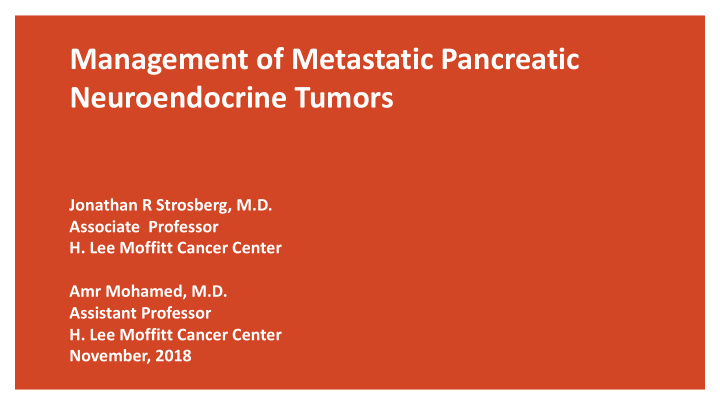



Management of Metastatic Pancreatic Neuroendocrine Tumors Jonathan R Strosberg, M.D. Associate Professor H. Lee Moffitt Cancer Center Amr Mohamed, M.D. Assistant Professor H. Lee Moffitt Cancer Center November, 2018
Case: Patient with metastatic well-differentiated pancreatic neuroendocrine tumor
Presenting symptoms § 73 year old male w presented with right hip pain, mild weight loss and difficulty controlled his blood sugars last December 2017 § X-ray was negative and MRI showed right labrum tear with multiple lytic lesions § CT scan performed
CT CAP Ø Pancreatic body and tail: solid mass measuring 6.5 cm Ø Liver: innumerable enhancing lesions Ø RP: extensive retroperitoneal lymphadenopathy Ø Bone: sclerotic lesions throughout the axial and proximal appendicular skeleton and lytic lesions L1, Rt femoral neck
FDG-PET scan: Low level of hypermetabolic activity throughout the known lesions
GA-68 GA-68 showed strong somatostatin expression throughout the multiple known lesions
Liver Biopsy (Rt Lobe) § Neuroendocrine tumor (Positive synaptophysin, and Chromogranin) § Well differentiated, grade 2 Grade 2 § Ki-67: 8% (Intermediate grade=grade2) § Low Mitotic Index
Diagnosis § Metastatic pancreatic neuroendocrine tumor likely a glucagonoma (Elevated baseline glucagon level: 832)
What is the next step of treatment? (A) Debulking surgery (B) Embolization of liver lesions (C) Watchful waiting (D) Somatostatin analog
Treatment § Pt was started treatment on started on Octerotide LAR 30 mg IM monthly § Disease remains stable x almost 2 years § Patient remains asymptomatic § Recent scans demonstrate stable pancreatic and bone lesions but increase in size of existing liver lesions and new liver lesions , bone lesions
Follow up Scans: § Pancreatic mass relatively stable § Progressive of liver and bone metastases
What is the next step? (A) Embolization of liver lesions (B) Switch to another Somatostatin analog (lanreotide) (C) Everolimus (D) Sunitinib (E) Capecitabine/Temozolomide (F) 177 Lutetium-dotatate
Treatment Everolimus Sunitinib Temozolomide +Capecitabine Phase III (RADIANT 3) III II (E2211) Patients # 207 86 144 Control arm Placebo Placebo Temozolomide alone Median PFS 11 vs 4.6 11·4 vs 5.5 22.7 vs. 14.4 (mos) Overall survival 44 vs 37.7 Not reached for either group Not reached vs. 38.0 (mos) (HR 0.94; 95% CI, 0.73-1.2; P = 0.30) (High number of censored (HR 0.41; 95% 0.21-0.82; P=0.01) events) Response rate (ORR) 5% 9% 33% Most common Hyperglycemia HTN Cytopenia side effect Stomatitis, Diarrhea Nausea & vomiting Nausea & vomiting Rash Diarrhea Diarrhea
Sunitinib vs. Everolimus in pancreatic NETs Comorbidity Favors sunitinib Favors everolimus Hypertension ü Cardiovascular disease ü Bleeding diathesis ü Risk of perforation/fistula ü Diabetes ü Underlying lung disease ü 14
Role of Peptide Receptor Radiotherapy (PRRT) in Pancreatic NETs § Approved both by EMA and FDA for advanced GEP-NETs § Phase 3 randomized data only in midgut NETs. § Advantages: Limited treatment course, long PFS, relatively low toxicity § Somatostatin-receptor (SSTR) expression is a predictive marker. § Early phase data suggesting higher response rates in non-midgut NETs (esp. pancreatic). § Consider as 2 nd line therapy in patients with strong SSTR expression.
The Rotterdam Experience 2000-2013 Median follow-up 78 months Brabander et al. Clin Cancer Res 2017;23:4617-4624
Objective Responses, PFS and OS Primary site Total PR +CR SD PD Median PFS and OS N (mo’s) N N % N % N % Midgut NET 181 57 31 99 55 16 9 30 60 Non-PD 32 10 31 18 56 3 9 24 82 PD 94 29 31 50 53 9 10 29 50 Pancreatic NET 138 72 55 40 30 17 13 30 71 Non-PD 21 10 48 10 48 1 5 31 ND PD 66 38 58 15 23 10 15 31 71 Hindgut 12 4 33 6 50 1 8 29 ND Bronchial 23 7 30 7 30 6 26 20 52 Other foregut 12 5 42 5 42 2 17 25 ND Unknown primary 82 29 35 35 43 11 13 29 53 Total 443 174 39 192 43 53 12 29 63 Brabander et al. Clin Cancer Res 2017;23:4617-4624
Pancreatic NETs Everolimus Somatostatin Analog Sunitinib Capecitabine + Relatively aggressive disease Temozolomide Strong somatostatin receptor PRRT expression Hepatic arterial Liver-dominant, relatively embolization unaggressive
More questions about PowerPoint?
Recommend
More recommend